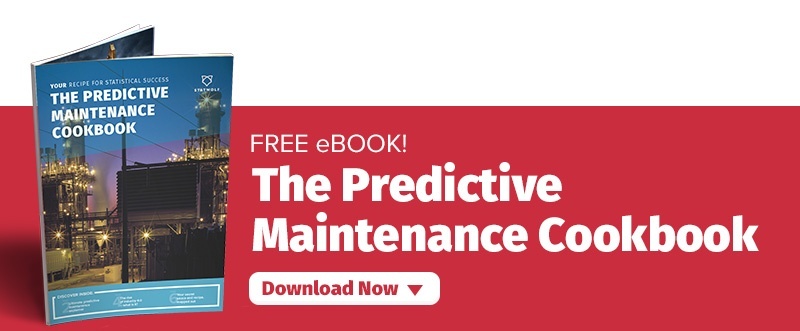5-step guide to cutting your plant’s unplanned downtime
At the 2017 ap&m Summit in London earlier this year, Vincent Swiderski, Airbus’ digital business developer, spoke about its two-part approach to predictive maintenance.
The first strand is an aircraft-centric method called Prognostics and Risk-Management (PRM). This digital programme combines calculations based on an aircraft condition monitoring system loaded onto the plane.
In the second part, Airbus utilises predictive maintenance to “contextualise information” from myriad data sources.
The company has saved operators $550,000 over 12 months – and it intends to save a further 5 to 10 percent in maintenance cost reductions through combining the two strands.
According to Swiderski, this is just, “the tip of the iceberg.”
While Airbus is an example of applying predictive maintenance to the aerospace industry, its uses are broad, encapsulating healthcare, finance, automotive and industry. In fact, predictive maintenance could revolutionise industrial business and how you run your plant, cutting downtime and saving huge sums of money.
Here’s how to do it in five steps.
1. Define your goal
Predictive maintenance determines the condition of in-service equipment in order to predict when maintenance should be performed. For years, the given maintenance technique in factories was preventive maintenance – where tasks were regularly performed on equipment to stop any potential downtime.
However, this often led to unnecessary costs, with resourcing going towards maintaining machines that didn’t necessarily need it.
Predictive maintenance aims to utilise information from your machines so they’re only repaired when they need to be – with the potential for huge cost savings. According to McKinsey, predictive maintenance will help companies save $630 billion by 2025.
However, these estimates come with a caveat: in order to be effective, a predictive maintenance regime needs to have a clear-cut goal.
Typically, maintenance managers are reactive: they respond to a breakdown after the fact. Setting a clear goal will help with this, but it needs to be specific. While reducing downtime may be the end-goal for your regime, you should attach a KPI or figure, i.e. reducing downtime in the packaging line by 10 percent using vibration analysis.
This makes it real and also gives your maintenance team a goal to work towards.
2. Complete an audit
Once you have an established goal, your next step is to consider the mass of data your factory produces. Typically, the subsets of data you’ll need for a predictive maintenance regime split into three:
1. Reference data: the baseline data that shows the normal behaviour of your machinery. This is historical/reference data that will inform the learning phase of a predictive regime
2. Operating data: the granular data your machinery produces as it runs.
3. Domain data: legacy data including maintenance manuals or information gathered from codifying your staff’s inherent knowledge.
Once you’ve gathered your initial data, you’ll need to collect information on previous work orders and data from any prior maintenance management software.
Following that, your next step is to mine your data on unplanned maintenance versus planned or preventative maintenance, as these two types of data should be analysed separately.
Once you have the core data, you’ll get an idea about the equipment which seems to be causing the most unplanned maintenance or downtime; these are the machines that will initially benefit most from predictive maintenance.
For example, IoT-powered predictive maintenance has made a huge impact on the petrochemical industry, especially with oil refineries.
The physical inspection of equipment located at deep ocean level is dangerous – which makes preventative maintenance particularly inefficient. Oil fields are often fitted with sensors (as they would be during a predictive regime) but much of the data goes unused.
Dyogram worked with an oil and gas customer to reduce operational costs and Non-Productive Time (NPT). The cost of NPT per asset during drill to completion on rigs is $500,000 to $1,000,000 per day.
Dyogram created an enterprise-ready solution that captures massive amounts of data in a cost-effective and scalable way, with everything running through a centralised data centre. The customer has saved millions and entirely streamlined their process thanks to identifying and utilising their information.
3. Engage with a data scientist
If you have the right software and team in place, your initial data-gathering shouldn’t be too laborious. However, the question then becomes what you’ll do with the data beyond its top-line usefulness.
Most industrial plants will have a maintenance team in place and the ability to mine their data to some extent, but the difference between a successful and unsuccessful predictive maintenance regime lies in the knowledge a data science team can bring.
In most cases, assembling a team of in-house data scientists and analysts isn’t cost-effective. Instead, consider consulting third-party data scientists who will have the inherent knowledge to maximise your data.
Tip: Don’t trust a third-party provider who promises results before examining your data. A predictive maintenance project is conducted step-by-step. Economic estimates should be measured against each step and its completion.
4. Decide on the algorithm that best suits your business
Airbus’ work with easyJet sees them take data from various sources and store it in the cloud. Algorithms based on end-user experience and engagement are then applied to contextualise that information.
Your ultimate goal will determine the shape of your algorithm, but essentially, it’s not about choosing the fanciest-sounding option. Instead, prioritise the end-result and its potential to impact on your plant’s downtime (and, in turn, its bottom line).
Mueller Industries is a company which used predictive maintenance to great effect. In business since 1917, it’s a multi-billion-dollar manufacturer and distributor of copper, brass, aluminium and plastic products. Initially implementing predictive maintenance on a trial basis, the company was blown away by the effectiveness of the new regime.
Pairing sensor technology with predictive knowledge, the company extended the operational life of machine components, eliminated catastrophic equipment failures, and reduced costs – and all thanks to a diagnostic system built around sound and vibrations.
5. Monitor, update, and see it through
Maintenance is a long-term play for any plant – the same goes for predictive maintenance. Once you have the algorithm and relevant equipment in place (e.g. sensors to monitor thermal readings on your production line), your maintenance team or third-party partner will need to constantly monitor and update the data.
Your predictive maintenance algorithm learns by building on the data and its context, increasingly spotting issues and flagging them in an efficient manner.
The early days of any predictive maintenance regime are, as Swiderski echoed, the tip of the iceberg. The true impact will come once the algorithm learns and grows, powering your machinery and your plant such that unplanned downtime and costly, ineffective maintenance are a thing of the past.
Want to find out more about predictive maintenance?
Whatever your predictive maintenance goals are, Statwolf's expertise can help you find the best solution for you and your business.
Our team of data scientists have worked on predictive maintenance programmes around the world so can help you with any queries you might have. Contact us today for more information or to trial a data science demo.
Want to make sense of your data? Download our comprehensive guide: The Predictive Maintenance Cookbook.



